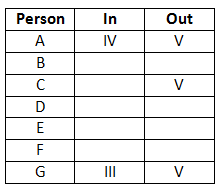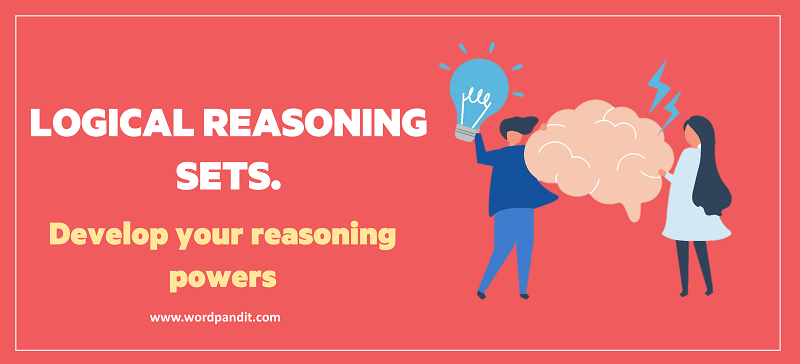logical reasoning skills: logical reasoning skills that you need to develop for the exams
Logical reasoning skills that are essentially tested in the exam are direction sense, arrangement sense, ordering, ranking, patterns, similarities/differences, conditional logic and blood relations. A basic understanding and development of these logical reasoning skills will surely fetch you a decent score. In order to score par excellence, you need to work on these skills individually and as a combination with one another and also work on solving them in a definite timeframe. In order to sharpen your logical reasoning skills, solve these exercise sets right till the difficult level (level-3).
Directions for the question set:
Study the following information carefully and answer the questions given below:
A, B, C, D, E, F and G are seven persons who travel to office every day by a particular train which stops at five stations – I, II, III, IV and V respectively after it leaves base station.
Three among them get on the train at the base station. D gets down at the next station at which F gets down. B does not get down either with A or E, G alone gets in at station III and gets down with C after one station. A travel between only two stations and gets down at station V. None of them gets in at station II. C gets in with F but does not get in with either B or D. E, gets in with two others and gets down alone after D, B and D work in the same office and they get down together at station III. None of them gets down at station I.
Question 1: At which station does E get down?
(a) II
(b) III
(c) IV
(d) Data inadequate
Question 2: At which station do C and F get in?
(a) I
(b) II
(c) III
(d) Data inadequate
Question 3: At which of the following stations do B and D get in?
(a) I
(b) Base station
(c) III
(d) None of these
Question 4: After how many stations does E get down?
(a) One
(b) Two
(c) Three
(d) Four
Question 5: E gets down after how many stations at which F gets down?
(a) Next station
(b) Two
(c) Three
(d) Four
Answers and Explanations: Click the down arrow to expand

B and D work in the same office and they get down together at station III. B does not get down either with A or E None of them gets down at station I. This means that E get in with C & F
D gets down at the next station at which F gets down. Means F get down at station at station number II. E, gets in with two others and gets down alone after D. This means that E gets in on base station.

E gets in on base station and two others are also getting in with him but these two could be anyone either C & F or B & D. From the directions and the above discussion, we can make a table for In and Out:

Answer 1: (c) E gets in with two others and gets down alone after D and we know that D gets down at station III. Hence, the correct option is (c).
Answer 2: (d) Since we know that E gets in at station III alone and there was nobody who gets in from station II, therefore D may be getting in from station number I or base station. Data is inadequate so the answer should be (d), because C and F get in either at Base station or station I. Hence, the correct option is (d).
Answer 3: (d) We know that B and D work in the same office and they get down together at station III. It means they cannot get in at station III so they also may get it from Base station or Station I. So none of these is the best answer. Hence, the correct option is (d).
Answer 4: (c) We know that E gets in with two others and gets down alone after D, B and D work in the same office and they get down together at station III . So E gets down after three stations. So the best answer to the question is E gets down after three stations (I, II And III). Hence, the correct option is (c).
Answer 5: (b) We know that D gets down at the next station at which F gets down and E gets in with two others and gets down alone after D, B and D work in the same office and they get down together at station III. From this it is clear that E gets down after two stations at which F gets down. Hence, the correct option is (b).
Extra tips for logical reasoning skills:
• In order to sharpen your logical reasoning skills practice interpreting sequences, series and relationships between shapes.
• Use Venn diagram approach to solve syllogism questions as it is highly foolproof.
• Use option elimination wherever applicable to save time.











